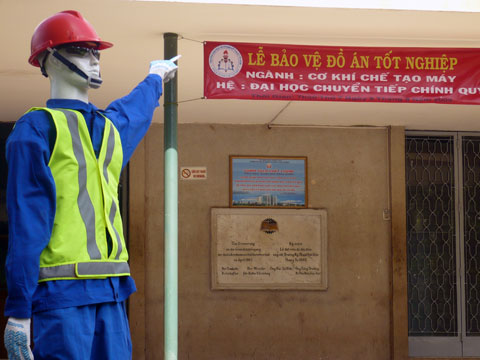Traffic control robot
At the crossroads, a 1.77-meter-tall robot, a human-like shape, is mastering traffic in a mature way.
Traffic control robot is researched and manufactured by a group of fourth year students, Department of Mechanical Engineering of Ho Chi Minh City University of Technical Education. Robots are built on the basis of combining various knowledge areas such as electronics, mechanics, programming control, computer communication, social investigation .
Support traffic police
Pham Tan Dat, the leader of the research team, said that when he started working on the robot, the group went to Thu Duc Police High School, District 9 Traffic Office, and then asked friends who were studying at police schools to apply for funding. whether, thanks to the instructions of the police movements when driving traffic, then shaping the technical solution for robots.
Thanks to the previous robocon competitions, the team has experienced and utilized a lot of old equipment to save costs. The group must also use cheap DC motors instead of expensive, precision motors.
In the distance, this robot is not different from the real one. According to Dat, a humanoid robot will have a greater impact on traffic participants than signal lights.

Compared to signal lights, traffic control robots will have a greater impact on pedestrians.
This robot operates according to the principle of receiving - processing images to make traffic control movements. "Input information" for robots are cameras located on street corners. This image will be transmitted to the computer and processed by software written by the group itself. From there, the control signal will be transmitted over the internet (by radio, or wired) to the robot. Thus, depending on the traffic situation on the intersections, the robot will give appropriate control moves. With 9 engines mounted in wrists, elbows and arms, the robot can perform 9 basic movements in traffic control: stretching your arms across, bringing your hands upright, folding the right angle, bringing it forward. .
High applicability
'Traffic control robot is available in Japan, Taiwan. But it only made simple movements to warn the danger zone. Therefore, I appreciate this idea of the research team ' , TS. Hieu, Head of Department of Electronics - Telecommunications, Ho Chi Minh City University of Natural Sciences, said. However, according to TS. Hieu, for practical application, the team needed to perfect the robot, such as synchronizing the robot's movements with the traffic lights.
Mr. Nguyen Tan Hoang Cuong, director of a company that used to offer solutions for a smart transportation system in Ho Chi Minh City, judged that the ability to apply this type of robot is "remarkable". He also suggested that 3G technology be used to transmit processing signals to robots.
According to Pham Tan Dat, the type of robot because the research team also has some disadvantages such as being damaged due to bad manufacturing materials, robot hands have not yet performed complicated movements. This robot cannot move as a real traffic cop. In addition, image processing software in this robot only observed 90% of vehicles.
- Robot replaced police and traffic lights
- Robot exits the laboratory causing traffic jams
- Scientific proof: Tail-running vehicles cause traffic jams
- Russia develops technology to control robots in space
- Fire control robot
- Philosophy for robots
- Having a mental problem because of traffic jams
- Robot knows how to control electronics
- Robot control by brain signal
- High mortality rates due to abolition of speed control
- Synchronize traffic lights to avoid traffic jams
- Robot controls people
 Daily use inventions come from universities
Daily use inventions come from universities Special weight loss device helps prevent appetite
Special weight loss device helps prevent appetite 8 inventors were killed by their own inventions
8 inventors were killed by their own inventions Iran invented a motor car powered by water
Iran invented a motor car powered by water